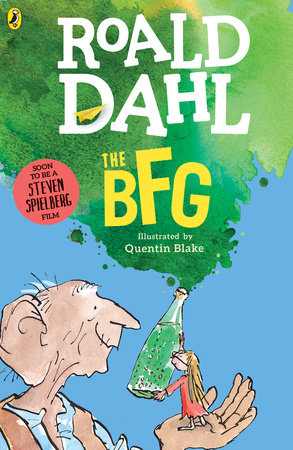I missed Roald Dahl’s The BFG when it appeared in 1982. Perhaps, being eleven, I thought I’d outgrown such things, busy instead with Judy Blume and L. M. Montgomery who wrote Anne of Green Gables. It would be thirty-three years before I read it—last year, at the behest of my Dahl enthusiast seven-year-old—and I loved it utterly and immediately. There’s often something completely pleasurable about reading a book written for young people as an adult.
The “BFG” is the Big Friendly Giant, spotted one night by a young orphan, Sophie, as he creeps around her village, mysteriously busy at its windows. With his magnificently attuned and supersonic hearing, the BFG hears Sophie’s heartbeat as she watches him, and since a giant should never be seen, he scoops her up and carries her out of England, out of the known world, and all the way back into Giant Country.
Here, she sees other giants with names like Childchewer, Maidmasher, and Fleshlumpeater—giants who, unlike the BFG, do, in fact, eat children. And it is here that she and the BFG hatch an audacious plan to alert the Queen of England, intercept these monstrous villains, and put an end to their cruel diet of “human beans” once and for all.
The plan revolves around the BFG’s secret business at windows in the night: he delivers dreams to children asleep inside. “I is a dream-blowing giant,” he explains. “When all the other giants is galloping off every what way and which to swollop human beans, I is scuddling away to other places to blow dreams into [their] bedrooms…”
A dream, he goes on, “is floating around in the air like little wispy-misty bubbles…making a tiny little buzzing-humming noise. And all the time they is searching for sleeping people.” The BFG, with his large ears, can hear them as they pass, particularly in the Dream Country, where he catches free-range phantasms to bottle, label, and store for later dispatch.
When I read this description of the mechanics of dreams, I felt that shiver that comes when something resonates as immediately innate and correct in a deep and particular part of your imagination. And from the physical description of the dreams themselves—an amalgam of “a blob of gas and a bubble of jelly”—to their taxonomy from best to worst (or from golden phizzwizards to trogglehumpers), Dahl’s delight in their evocation, as much as their possibilities, is both palpable and infectious.
As with many of Dahl’s stories, The BFG is about to become a film, with a cast including Mark Rylance as the BFG and Jemaine Clement as the Fleshlumpeater. Slated for release on July 1, it looks as promisingly fantastic as you’d expect from a three-way collaboration between Dahl, Disney, and Steven Spielberg.
But I’m glad I came to the book first. Part of its appeal is the vivid poetry of Dahl’s explanation of a thing that remains genuinely mysterious—the very business of why, what, and how we dream—and the delightful suspicion that perhaps his explanation is correct.
Racing through its pages, tucked as safe and snug in the imagination of a master storyteller as Sophie herself is tucked in the BFG’s pocket, I realized there was something utterly thrilling about the idea that the very course of the world might be changed—and saved—by the perfect combination of a little girl, a magical man, and a universe of available dreams.
Ashley Hay is the internationally acclaimed author of four nonfiction books, including The Railwayman’s Wife.





